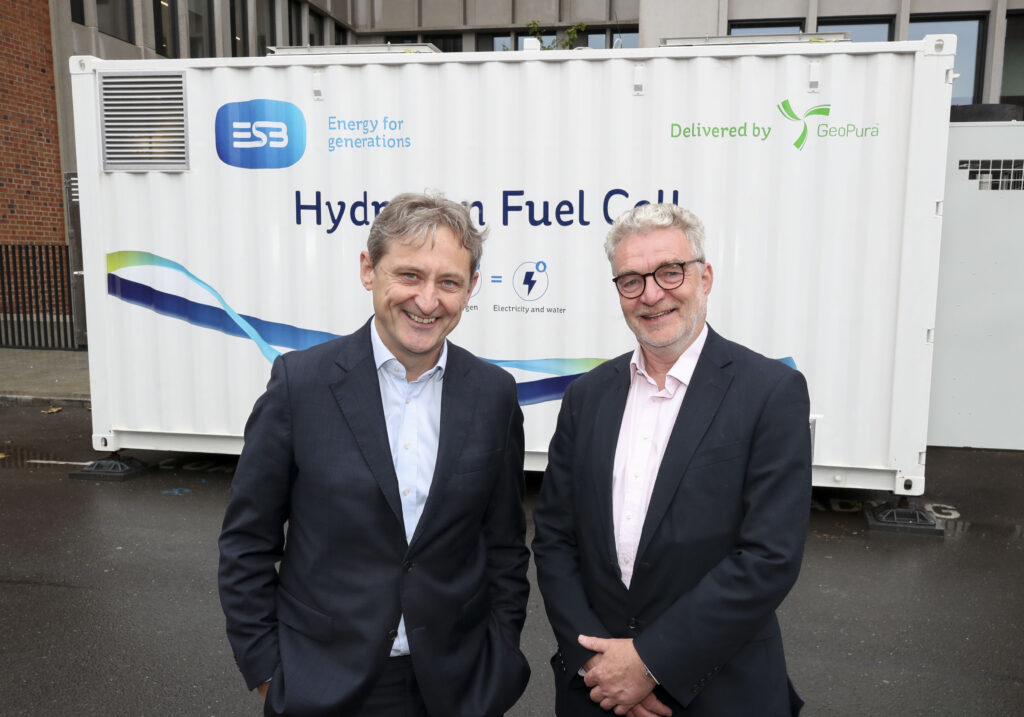ESB has introduced new hydrogen power generation demonstration fuel cells, marking the first use of hydrogen to electricity in Ireland. The demonstration is hosted this week at ESB’s head office on Fitzwilliam Street, Dublin 2.
The units, produced by UK-based renewable energy company GeoPura and partner Siemens Energy, utilize fuel cell technology to convert hydrogen into electricity. This technology can provide up to 250kW of clean power, with pure water being the only by-product.
Benefits of Green Hydrogen for Ireland
In a net zero world, converting renewable energy into green hydrogen and storing it for use when solar and wind power are unavailable will be highly beneficial. This process involves the deployment of electrolysers (electricity to hydrogen) and fuel cells (hydrogen to electricity).
Phased Demonstration Project
The fuel cells’ deployment is the first phase of a green hydrogen lighthouse project. The second phase involves deploying an electrolyser at ESB’s Aghada Power Station in Co Cork, with overall project completion expected in 2025.
Upon completion, ESB will demonstrate converting electricity to hydrogen and hydrogen back to electricity. This will also showcase green hydrogen’s role in reducing emissions, especially in hard-to-abate industrial processes and transport applications like heavy goods vehicles and aviation.
Industry Leaders’ Comments
Jim Dollard, ESB Executive Director, Generation and Trading, stated:
We know that to reach net zero within our timeframe, other sources of clean energy will be needed to support Ireland’s electricity system.
“At ESB, we believe green hydrogen is a crucial source. We are excited to see firsthand how the hydrogen power units will operate as part of the Lighthouse Project. We thank our partner, GeoPura, for their innovative work. This project will help us understand the future role of green hydrogen in a net zero energy system, providing backup electricity when wind and solar are insufficient.
Alistair Gemmell, Chief Business Development Officer at GeoPura, commented:
We’re thrilled to partner with ESB on this groundbreaking project, marking a significant step towards a zero-carbon future for Ireland.
“By demonstrating that green hydrogen can replace fossil fuels for power generation, ESB is leading efforts to reduce emissions and improve air quality. This ambitious Lighthouse Project sets a strong example and we look forward to further supporting ESB’s hydrogen strategy to reduce Ireland’s emissions.
Versatile Application and National Strategy
These units have previously powered large-scale events, including festivals and television productions, and have replaced diesel generators in construction settings. ESB plans a series of demonstrations across Ireland in late 2024 and early 2025 to showcase hydrogen fuel cell technology’s versatility.
This project aligns with Ireland’s National Hydrogen Strategy, highlighting hydrogen’s role in decarbonizing challenging economic sectors and enhancing energy security. Green hydrogen is produced from renewable sources like hydro, wind, or solar.
READ the latest news shaping the hydrogen market at Hydrogen Central
ESB launches new hydrogen power demonstration to showcase first deployment of hydrogen to electricity in Ireland. source
Original Story at hydrogen-central.com

